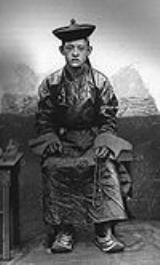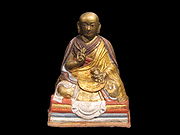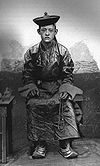
Jebtsundamba
Encyclopedia
The Khalkha Jebtsundamba Khutuktus ' onMouseout='HidePop("53864")' href="/topics/Tibetan_language">Tibetan
: རྗེ་བཙུན་དམ་པ་ Jetsun Dampa; literally, "Holy Venerable Lord") were the spiritual heads of the Gelug
lineage of Tibetan Buddhism
in Mongolia
. They also held the title of Bogd Gegeen, making them the top-ranked lama
s in Mongolia.
 The first Jebtsundamba, Zanabazar (1635–1723), was identified as the reincarnation
The first Jebtsundamba, Zanabazar (1635–1723), was identified as the reincarnation
of the scholar Taranatha
of the Jonang
school of Tibetan Buddhism. Zanabazar was the son of the Tüsheet Khan Gombodorj, ruler of central Khalkha
Mongolia, and himself became the spiritual head of the Khalkha
Mongols
.
Like Zanabazar, the second Jebtsundamba also was a member of Mongolia's highest nobility and direct descendant of Genghis Khan
. After Chingünjav
's rebellion and the successive demise of the second Jebtsundamba Khutugtu, the Qianlong emperor decreed in 1758 that all future reincarnations were to be found from among the population of Tibet
.
When northern Mongolia declared independence in 1911, the eighth Jebtsundamba (1869–1924) was elevated as the Emperor of Mongolia, called Bogd Khan
. He was the head of state until his death in 1924. The Communist government declared that there were to be no further reincarnations.
A reincarnation was in fact found almost at once in north Mongolia, and some high lamas of the dead Khutughtu's suite went to interview the child's mother, Tsendjav, and to instruct her in the details of the life of the former incarnation, so that she could familiarize the child-candidate with the tests which he would have to undergo. Faced with the possibility of a new Khutughtu who was born within Mongolia and was not even a foreigner from Tibet, the Communist Party Central Committee in July 1925, decided to turn the matter over to the aged Dalai Lama
in Lhasa
, whose decision would nonetheless be subject to the new law for the separation of Church and State. In February 1929 the installation of any further Khutughtus was forbidden.
A 9th Jebtsundamba Khutuktu has been installed by the Dalai Lama. He was born as Jampal Namdol Chökyi Gyaltsen in 1932.
 Bogdo gegeen (Mongolian and ceremonial Tibetan-language names)
Bogdo gegeen (Mongolian and ceremonial Tibetan-language names)
Tibetan language
The Tibetan languages are a cluster of mutually-unintelligible Tibeto-Burman languages spoken primarily by Tibetan peoples who live across a wide area of eastern Central Asia bordering the Indian subcontinent, including the Tibetan Plateau and the northern Indian subcontinent in Baltistan, Ladakh,...
: རྗེ་བཙུན་དམ་པ་ Jetsun Dampa; literally, "Holy Venerable Lord") were the spiritual heads of the Gelug
Gelug
The Gelug or Gelug-pa , also known as the Yellow Hat sect, is a school of Buddhism founded by Je Tsongkhapa , a philosopher and Tibetan religious leader...
lineage of Tibetan Buddhism
Tibetan Buddhism
Tibetan Buddhism is the body of Buddhist religious doctrine and institutions characteristic of Tibet and certain regions of the Himalayas, including northern Nepal, Bhutan, and India . It is the state religion of Bhutan...
in Mongolia
Mongolia
Mongolia is a landlocked country in East and Central Asia. It is bordered by Russia to the north and China to the south, east and west. Although Mongolia does not share a border with Kazakhstan, its western-most point is only from Kazakhstan's eastern tip. Ulan Bator, the capital and largest...
. They also held the title of Bogd Gegeen, making them the top-ranked lama
Lama
Lama is a title for a Tibetan teacher of the Dharma. The name is similar to the Sanskrit term guru .Historically, the term was used for venerated spiritual masters or heads of monasteries...
s in Mongolia.
History

Reincarnation
Reincarnation best describes the concept where the soul or spirit, after the death of the body, is believed to return to live in a new human body, or, in some traditions, either as a human being, animal or plant...
of the scholar Taranatha
Taranatha
Tāranātha was a Lama of the Jonang school of Tibetan Buddhism. He is widely considered its most remarkable scholar and exponent....
of the Jonang
Jonang
The Jonang is one of the schools of Tibetan Buddhism. Its origins in Tibet can be traced to early 12th century master Yumo Mikyo Dorje, but became much wider known with the help of Dolpopa Sherab Gyeltsen, a monk originally trained in the Sakya school...
school of Tibetan Buddhism. Zanabazar was the son of the Tüsheet Khan Gombodorj, ruler of central Khalkha
Khalkha
Khalkha is the largest subgroup of Mongol people in Mongolia since 15th century. The Khalkha together with Tsahar, Ordos and Tumed, were directly ruled by the Altan Urag Khans until the 20th century; unlike the Oirat people who were ruled by the Dzungar nobles or the Khorchins who were ruled by...
Mongolia, and himself became the spiritual head of the Khalkha
Khalkha
Khalkha is the largest subgroup of Mongol people in Mongolia since 15th century. The Khalkha together with Tsahar, Ordos and Tumed, were directly ruled by the Altan Urag Khans until the 20th century; unlike the Oirat people who were ruled by the Dzungar nobles or the Khorchins who were ruled by...
Mongols
Mongols
Mongols ) are a Central-East Asian ethnic group that lives mainly in the countries of Mongolia, China, and Russia. In China, ethnic Mongols can be found mainly in the central north region of China such as Inner Mongolia...
.
Like Zanabazar, the second Jebtsundamba also was a member of Mongolia's highest nobility and direct descendant of Genghis Khan
Genghis Khan
Genghis Khan , born Temujin and occasionally known by his temple name Taizu , was the founder and Great Khan of the Mongol Empire, which became the largest contiguous empire in history after his death....
. After Chingünjav
Chingünjav
Chingünjav was one of the two major leaders of the 1755 - 1756 rebellion in Outer Mongolia. Although his rebellion failed, he is nowadays often hailed as a fighter for Mongolia's independence from the Manchu, who were ruling China at that time....
's rebellion and the successive demise of the second Jebtsundamba Khutugtu, the Qianlong emperor decreed in 1758 that all future reincarnations were to be found from among the population of Tibet
Tibet
Tibet is a plateau region in Asia, north-east of the Himalayas. It is the traditional homeland of the Tibetan people as well as some other ethnic groups such as Monpas, Qiang, and Lhobas, and is now also inhabited by considerable numbers of Han and Hui people...
.
When northern Mongolia declared independence in 1911, the eighth Jebtsundamba (1869–1924) was elevated as the Emperor of Mongolia, called Bogd Khan
Bogd Khan
The Bogd Khan was enthroned as the Great Khaan of Mongolia on 29 December 1911, when Outer Mongolia declared independence from the Qing Dynasty after the Xinhai Revolution. He was born in the Kham region of eastern Tibet, today's Sichuan province of the People's Republic of China...
. He was the head of state until his death in 1924. The Communist government declared that there were to be no further reincarnations.
A reincarnation was in fact found almost at once in north Mongolia, and some high lamas of the dead Khutughtu's suite went to interview the child's mother, Tsendjav, and to instruct her in the details of the life of the former incarnation, so that she could familiarize the child-candidate with the tests which he would have to undergo. Faced with the possibility of a new Khutughtu who was born within Mongolia and was not even a foreigner from Tibet, the Communist Party Central Committee in July 1925, decided to turn the matter over to the aged Dalai Lama
Dalai Lama
The Dalai Lama is a high lama in the Gelug or "Yellow Hat" branch of Tibetan Buddhism. The name is a combination of the Mongolian word далай meaning "Ocean" and the Tibetan word bla-ma meaning "teacher"...
in Lhasa
Lhasa
Lhasa is the administrative capital of the Tibet Autonomous Region in the People's Republic of China and the second most populous city on the Tibetan Plateau, after Xining. At an altitude of , Lhasa is one of the highest cities in the world...
, whose decision would nonetheless be subject to the new law for the separation of Church and State. In February 1929 the installation of any further Khutughtus was forbidden.
A 9th Jebtsundamba Khutuktu has been installed by the Dalai Lama. He was born as Jampal Namdol Chökyi Gyaltsen in 1932.
List of Jebsundamba Khutuktu

- 1635 - 1723 Öndör Gegeen Zanabazar (Blo-bzang-bstan-pa'i-rgyal-mtshan), 1st Jebtsundamba Khutughtu
- 1724 - 1757 Luvsandambiydonmi (Blo-bzang-bstan-pa'i-srgon-me), 2nd Jebtsundamba Khutughtu2nd Jebtsundamba KhutughtuThe 2nd Jebtsundamba Khutughtu , was the second incarnation of the Jebtsundamba Khutuktu, the spiritual heads of the Gelug lineage of Tibetan Buddhism in Mongolia...
- 1758 - 1773 Ishdambiynyam (Ye-shes-bstan-pa'i-nyi-ma), 3rd Jebtsundamba Khutughtu3rd Jebtsundamba KhutughtuThe 3rd Jebtsundamba Khutughtu , was the third incarnation of the Jebtsundamba Khutuktu, the spiritual heads of the Gelug lineage of Tibetan Buddhism in Mongolia...
- 1775 - 1813 Luvsantüvdenvanchug (Blo-bzang-thub-bstan-dbang-phyug), 4th Jebtsundamba Khutughtu
- 1815 - 1841 Luvsanchültimjigmed (Blo-bzang-tshul-khrim-'jigs-med), 5th Jebtsundamba Khutughtu
- 1843 - 1848 Luvsantüvdenchoyjijaltsan (Blo-bzang-dpal-ldan-bstan-pa), 6th Jebtsundamba Khutughtu6th Jebtsundamba KhutughtuThe 6th Jebtsundamba Khutughtu , was the sixth incarnation of the Jebtsundamba Khutuktu, the spiritual heads of the Gelug lineage of Tibetan Buddhism in Mongolia...
- 1850 - 1868 Agvaanchoyjivanchugperenlaijamts (Ngag-dbang-chos-kyi-dbang-phyug-'phrin-las-rgya-mtsho), 7th Jebtsundamba Khutughtu
- 1870 - 20 May 1924 Agvaanluvsanchoyjindanzanvaanchigbalsambuu (Ngag-dbang-blo-bzang-chos-rje-nyi-ma-bstan-'dzin-dbang-phyug rJe-btsun-dam-pa Bla-ma), 8th Jebtsundamba Khutughtu and Bogd KhanBogd KhanThe Bogd Khan was enthroned as the Great Khaan of Mongolia on 29 December 1911, when Outer Mongolia declared independence from the Qing Dynasty after the Xinhai Revolution. He was born in the Kham region of eastern Tibet, today's Sichuan province of the People's Republic of China...
(b. 1869 - d. 1924) - 1936 - Jambalnamdolchoyjijantsan, (Jampal Namdrol Chokye Gyaltsen), 9th Jebtsundamba Khutughtu9th Jebtsundamba KhutughtuThe 9th Jebtsundamba Khutuktu is supposed to continue the incarnation line of the Jebtsundamba Khutughtus in Mongolia. From the 17th century until 1924, the Jebtsundamba Khutughtus were the spiritual heads of the Gelug lineage of Tibetan Buddhism among the Khalkha Mongols...
(b.1932) (from 1991, recognized by the Dalai Lama) (in Tibet exile to 1959, then in India)

